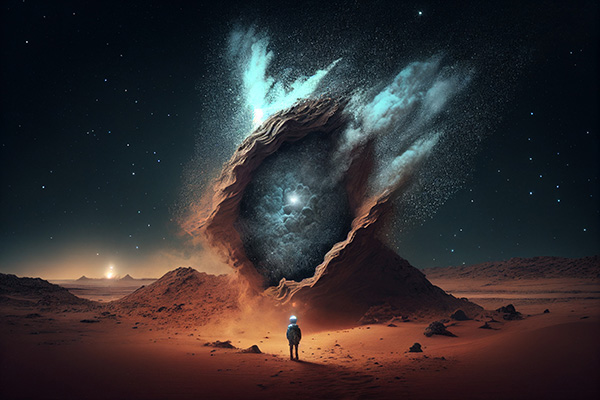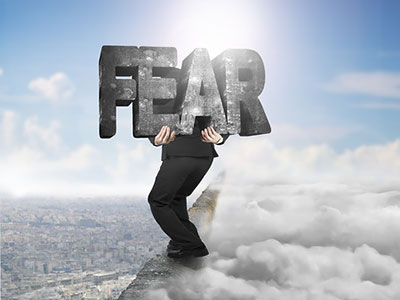Self-Help
Be Your Own Light In Times Of Darkness
 We’ve been facing dark days and challenging times across the world in recent years, no matter where we live. But the future is much brighter than it may seem, and that light of hope begins with you.
We’ve been facing dark days and challenging times across the world in recent years, no matter where we live. But the future is much brighter than it may seem, and that light of hope begins with you.
With social media and constant news feed updates, mostly centered around negativity, disaster, conflict, or tragedy, many of us feel overwhelmed these days. These are especially not easy times for the spiritually conscious person and the highly sensitive.
Our generation is being bombarded with a stream of distressing information and content, much of which includes falsehoods and fearmongering. Children today are exposed to more in grade school than some of us were after we graduated and entered the workforce. That’s not always a good thing, but it also means they’re growing up faster, and with the right guidance, they can grow up wiser.
When people talk about “the good old days,” they’re usually thinking about how much simpler life seemed in the past. I remember my grandparents saying such things long before there was the internet, smartphones, or AI. So, I guess every generation has its own reasons for nostalgia, and this sentiment is nothing new in the digital age.
That said, some of us today still grew up without television or even radio, and lived through the full evolution of the current digital age. Many elders still feel disconnected from how rapidly things have changed. But there’s beauty in that too. Each generation carries wisdom, and now, more than ever, we need to blend that wisdom with the tools of today to create a better path forward for all of us.
The Mysteries, Messages And Magic Of Meteorites
 Meteorites have long intrigued me as one of the great mysteries of the universe. They’ve fascinated me for years, not only because they survive their fiery descent through Earth’s atmosphere in such an epic and awe-inspiring way, but also because of their extraordinary origins.
Meteorites have long intrigued me as one of the great mysteries of the universe. They’ve fascinated me for years, not only because they survive their fiery descent through Earth’s atmosphere in such an epic and awe-inspiring way, but also because of their extraordinary origins.
Recently, I acquired a small piece of meteorite from Campo del Cielo, a renowned celestial fragment discovered by Spanish explorers in Argentina in 1576. It now graces my altar with it cosmic presence, enhancing the energy of my home and sparking some fun conversations!
Their origins are diverse. Some come from asteroids or comets, others from planetary bodies.
However, what I find especially captivating about these “messengers from space” is that they offer more than just scientific insights into the birth of our solar system.
Even more compelling is the spiritual and esoteric significance they’ve held throughout human history. Across time and tradition, they continue to be revered as powerful allies in spirituality and metaphysics.
Many lithotherapy practitioners believe meteorites are gifts from the divine, reminding us of our eternal connection to the cosmos. They are symbols of spiritual awakening, transformation, and divine wisdom.
Ancient civilizations used them for meditation and healing, to connect with higher realms, and to catalyze personal growth. Because they are quite literally “otherworldly,” meteorites offer us a cosmic perspective and invite us to reflect on our place within the grand tapestry of existence.
Spiritual Strategies For A Loving Relationship
 Over the years I have worked with many clients who either want to improve an existing relationship or manifest a new relationship.
Over the years I have worked with many clients who either want to improve an existing relationship or manifest a new relationship.
In my readings, I have seen that most of us carry patterns, energy blocks, or emotional knots that quietly affect our love lives. Many people describe the same inner cycle: a longing for deeper connection followed by fear, self-doubt, and frustration.
Depending on the needs to the particular individual or couple, I often recommend a few simple yet powerful practices that can shift the romantic energy field and open the heart.
These practices are gentle and effective, working not just on the emotional level but on the spiritual and energetic levels as well. They help clients reconnect with their inner wisdom and realign with love.
We tend to overthink our love lives. We analyze our relationships from every angle, hoping to find the answers in logic.
But love is not a puzzle to be solved. It is a frequency to be attuned to. And when we work with spiritual tools, we allow ourselves to rise above the clutter of thought and enter a state of clarity and openness.
I have found that the following practices, when done consistently, create a soft and supportive foundation for emotional healing and soulful connection. They do not require dramatic effort or complex rituals. They are simple shifts in intention and awareness that can lead to powerful outcomes.
False Education Appearing Real (F.E.A.R)
 I love the acronym F.E.A.R. (False Education Appearing Real) since we all have people, circumstances, phobias and so forth, that can put us into that space.
I love the acronym F.E.A.R. (False Education Appearing Real) since we all have people, circumstances, phobias and so forth, that can put us into that space.
Fear is an instance of emotion that is triggered by the awareness, or anticipation of danger. It can also become a state of being. Excluding clinical fears, needing professional help, there are many fears we simply impose upon ourselves as a result of life experiences.
One of my fears is acrophobia, the fear of heights. When I get within five feet from the edge of a rooftop, I begin to shake.
Climbing 30 foot ladders has me nervous and when I hiked to the pinnacle of the mountain of Macchu Picchu in 2004, I could not take those last six nervous steps onto the plateau pinnacle rock. This was partly being due to a few other tourists already sharing the rock… and I am a little “accident prone.”
Although I was invited by my partner and the guide, I leaned against the rock debating my fear, shaking a little at the prospect and wishing that I could take those final steps, as I might regret it after I hiked down. Part of me did regret not taking those last steps when we got back to the base.
Yet, a bigger part of me knew I had to acknowledge the feelings in the moment, and since I am not a regular exerciser, I already had accomplished something tremendous by taking the hike to the top and back down the back side of the mountain. On the way I enjoyed the magnificent views and spiritual energy for several hours. Continue reading
What Makes A Spiritual Group Truly Work
 We are all different. Each person is a piece of the puzzle that creates a group. All people are raised different. People may have different spiritual beliefs, different educational backgrounds, jobs, nationalities.
We are all different. Each person is a piece of the puzzle that creates a group. All people are raised different. People may have different spiritual beliefs, different educational backgrounds, jobs, nationalities.
Yet, if the common goal is the same, there is no reason why we cannot achieve much more in our world. Some of us simply need to find a way to respect diversity.
Spiritual groups tend to be the especially challenging when it comes to diversity. Too often spiritually-minded people are expected to always agree with everyone about everything, in order to promote goodwill among group members and keep the peace.
But in any group people have to learn how to agree to disagree. It’s always okay to have your own opinion and express how you feel. One must just remember that not all of the group may agree with your thoughts.
In groups people all choose different roles, and the roles may change over time. Most groups have that one person that assumes the role of leader. The leader of the group is often selected by the majority. The leadership role usually fits the personality and consciousness of that individual, as do the other roles in the group.
The leader is usually a person that is able to communicate well with team members and good at listening to people. The ‘worker bees’ are usually good at taking direction and accomplishing the task at hand. Somewhere in the middle are the people that come up with ideas and can present them to the group, and help the suggestions come to fruition.

